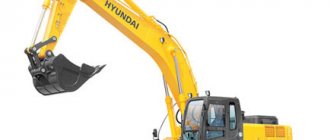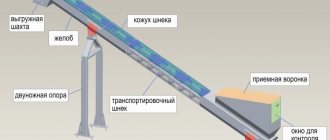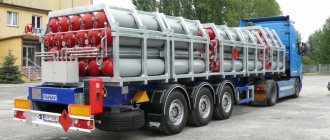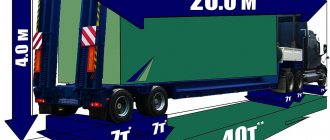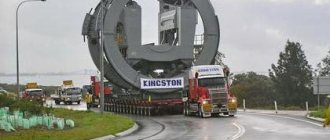Rules for the transportation of large and heavy cargo
In order to efficiently organize the transportation of cargo, it is necessary to always (!) carefully measure its dimensions and weight. Moreover, if the cargo must “travel” packaged, then it is necessary to weigh and take measurements both before it is packaged and when it is already in the container.
Accurate determination of the weight and dimensions of the cargo in any case influences the correct choice of vehicle: why incur additional difficulties and costs of fines by “stuffing”, for example, a product weighing 8 tons into a car designed for six tons, or a load 3.5 long meters - into a standard Gazelle (2.8 m), if there are vehicles with greater cargo capacity, extended versions of the Gazelle, etc. and so on.?
However, at the same time, it is often necessary to transport cargo that, due to its dimensions, cannot fit into any of the existing vehicles or whose weight exceeds the permissible load on the road surface. Moreover, there is no way to separate these cargoes or disassemble them in order to transport them in batches.
For example: generators, transformers, long pipes, agricultural and road equipment, presses, drilling rigs, tanks for petroleum products, etc.
In this case, we will be talking about large-sized and (or) heavy cargo, and their transportation will require special preparation: obtaining permission, coordinating the route, tolls on roads, developing a special transportation project, organizing escort... And if any of the necessary points are not fulfilled, the carrier will face a small fine.
Therefore, it is very important to know all the subtleties and nuances of transporting oversized cargo and strictly follow the prescribed conditions.
However, first you need to know when exactly the cargo begins to be considered oversized.
So, the cargo is oversized if its dimensions exceed the established maximum permissible values for at least one of the parameters:
height (with the car): 4 meters; width: for all vehicles - 2.55 meters, for isothermal bodies - 2.6 meters; length: for trailers and single vehicles - 12 meters, for a road train - 20 meters; In this case, not only the length of the cargo is important, but also how much it exceeds the length of the vehicle: the overhang of the cargo is allowed no more than 2 (!) meters.
As for a heavy load, it will be such if it exceeds either the established weight limits (by the way, in this case the combined weight of the load and the vehicle is calculated!), or the permissible axial loads.
Permissible vehicle weights
| vehicle type, number and location of axles | permissible vehicle weight (in tons) |
| single cars | |
| biaxial | 18 |
| triaxial | 25 |
| four-axle | 32 |
| five-axis | 35 |
| fifth wheel and trailed road trains | |
| triaxial | 28 |
| four-axle | 36 |
| five-axis | 40 |
| six-axis and more | 44 |
Permissible axle loads of vehicles
| location of vehicle axles | distance between adjacent axes (in meters) | permissible axle loads of wheeled vehicles depending on the standard (calculated) axle load (tons) and the number of wheels on the axle | ||
| for highways designed for an axle load of 6 tons/axle | for highways designed for an axle load of 10 tons/axle | for highways designed for an axle load of 11.5 tons/axle | ||
| Singles | over 2.5 | 5,5 (6) | 9 (10) | 10,5 (11,5) |
| Twin axles of trailers, semi-trailers, trucks, tractor units, truck tractors with the distance between the axles (load on the bogie, sum of axle masses) | up to 1 (inclusive) | 8 (9) | 10 (11) | 11,5 (12,5) |
| over 1 to 1.3 (inclusive) | 9 (10) | 13 (14) | 14 (16) | |
| over 1.3 to 1.8 (inclusive) | 10 (11) | 15 (16) | 17 (18) | |
| over 1.8 to 2.5 (inclusive) | 11 (12) | 17 (18) | 18 (20) | |
| Triple axles of trailers, semi-trailers, trucks, tractor units, truck tractors with the distance between the axles (load on the bogie, sum of axle masses) | up to 1 (inclusive) | 11 (12) | 15 (16,5) | 17 (18) |
| over 1 to 1.3 (inclusive) | 12 (13) | 18 (19,5) | 20 (21) | |
| over 1.3 to 1.8 (inclusive) | 13,5 (15) | 21 (22,5) | 23,5 (24) | |
| over 1.8 to 2.5 (inclusive) | 15 (16) | 22 (23) | 25 (26) | |
| Closed axles of trucks, tractor-trailers, truck tractors, trailers and semi-trailers with more than three axles at a distance between the axles (load per axle) | up to 1 (inclusive) | 3,5 (4) | 5 (5,5) | 5,5 (6) |
| over 1 to 1.3 (inclusive) | 4 (4,5) | 6 (6,5) | 6,5 (7) | |
| over 1.3 to 1.8 (inclusive) | 4,5 (5) | 6,5 (7) | 7,5 (8) | |
| over 1.8 to 2.5 (inclusive) | 5 (5,5) | 7 (7,5) | 8,5 (9) | |
| Close axles of vehicles with eight or more wheels on each axle (load per axle) | up to 1 (inclusive) | 6 | 9,5 | 11 |
| over 1 to 1.3 (inclusive) | 6,5 | 10,5 | 12 | |
| over 1.3 to 1.8 (inclusive) | 7,5 | 12 | 14 | |
| over 1.8 to 2.5 (inclusive) | 8,5 | 13,5 | 16 | |
(Values in parentheses are for dual-slope wheels, without brackets - for single-slope wheels.)
If the parameters of the cargo “failed” at least one of the given values (length, width, height, weight), then, we repeat, it is large-sized and (or) heavy, which means that it is necessary to obtain a special permit for its transportation.
Who issues permission to transport oversized cargo across the territory of the Russian Federation?
In fact, it all depends on which route the cargo will take.
- If the path (or part of the path) runs along federal roads or through the territory of two or more constituent entities of the Russian Federation, then you should apply for permission to the Federal Road Agency (Rosavtodor)
. - If along highways of regional or intermunicipal importance (or across the territory of two or more municipalities, which is important - within the boundaries of a subject), without affecting federal highways, to the executive authority of the subject of the Russian Federation.
- If along local roads of a municipal district (or along the territory of two or more settlements within the boundaries of a municipal district) - to the local government body of the municipal district.
- If along local highways of a settlement, provided that the route of the vehicle passes within the boundaries of such a settlement, - to the local government body of the settlement.
- If on local roads of the urban district - to the local government body of the urban district.
- If on a private road - to the owner of the road.
However, regardless of which authority you should contact for permission, the package of necessary documents will be the same. It includes:
- application (indicating the route of travel, type of transportation, timing of its implementation, number of trips; characteristics of the cargo - dimensions, weight, divisibility; information about the vehicle - registration plate, make and model, weight, distance between axles, dimensions; data on organizational legal form of the carrier);
- copies of documents for the vehicle (passport or registration certificate);
- a diagram of the vehicle showing the number of axles and wheels and their relative positions, indicating the distribution of load along the axles and securing the load;
- information on technical requirements for the transportation of the declared cargo in transport position.
Basically, once the application is submitted, all the carrier can do is wait. Rosavtodor (or another authorized body) establishes which other sections of roads (except those under its direct control) the route of the vehicle passes (for example, along roads of regional, municipal, etc. significance), determines their owners and directs to them an application for approval of the route. When a response is received from each department and if the response is positive, the applicant is issued an invoice for compensation for the harm caused. Once the invoice is paid and proof of payment (copies of payment documents) is provided, the carrier is issued a special permit and can begin the transportation process. In this case, by the way, the maximum period from the date of filing the application to receiving the permit is 11 working days.
In this case, the permit can be either one-time or multiple-use - for several (no more than 10) trips of the same type: along a specific route with similar cargo.
However, often coordinating the route for transporting oversized and/or heavy cargo requires more time and includes more steps.
What is a special transportation project and in what cases is it developed?
If the cargo being transported along with the vehicle is higher than 4.5 meters, then in order to deliver it to its destination, it is necessary to develop a special route along which the vehicle will not have to pass through tunnels, railroad crossings, under bridges, etc. Moreover, in cases where, for example, you avoid driving under power grids, transmission lines, etc. If it doesn’t work, you will have to use special equipment during the transportation of cargo to lift them or build various detours.
In the same way, you will have to develop a special project, a traffic schedule, organize a special route and take increased transportation safety measures if the width of the cargo exceeds 5 meters and the length is 35 meters.
When the cargo, together with the vehicle carrying it, weighs more than 44 tons, then, in addition to coordinating the route, it will also be necessary to assess the technical condition of the roads (will they be able to withstand the expected load?) or even strengthen the road surfaces.
In all these cases, it is necessary to approve the route, travel options for the vehicle and measures to ensure its movement with those who own certain infrastructure facilities (for example, power lines), as well as with the traffic police. What greatly simplifies the procedure is that all steps for approval, project development, etc. undertaken by the authorized body responsible for issuing the permit. True, the time frame for issuing a permit is naturally extended, and a separate fee is provided for all additional work on organizing the route.
In addition, it will be necessary to coordinate the route with the owner of the railway infrastructure in cases where the transported cargo is higher than 4.5 meters, when the length of the vehicle with trailer is more than 22 meters (or the road train has two or more trailers) or when the vehicle is moving at a speed of less than 8 km /h.
Is it always necessary to obtain a permit to transport heavy cargo?
No not always. A permit is not required if the vehicle's cargo weight or axle load is only 2 percent (or less)
exceeds permissible values.
If the excess is more than 2 percent, but less than 10 percent
, then the permit is issued in a simplified manner.
By the way, what is important to know: you cannot transport large-sized and/or heavy divisible cargo! If the cargo can be disassembled easily and without damage, then it should be transported in this disassembled form. There is only one exception: if the vehicle weight, axle load, width, length or height exceed the maximum permissible values by less than 2 percent
, then a vehicle carrying such cargo can still travel on roads. But you still need to get special permission first!
In addition, when organizing the transportation of large and/or heavy cargo, you must take into account that in some cases this cargo will require special escort
.
This need is easy to explain: if, for example, a loaded vehicle moves out of its lane, someone must warn the oncoming traffic in advance about the possible danger. Or stop the movement while the road train is turning with a big skid. Or pre-measure the height at which power lines, etc. are located to determine whether a vehicle with a high load can pass under them or not.
There are several options for accompanying oversized and/or heavy cargo:
- cover car;
- escort vehicle.
A cover vehicle, as a rule, is provided by the shipper or carrier or hired from outside. It is necessary throughout the journey in cases where:
- height of a vehicle with a load of more than 4.5 meters;
- the width of the load exceeds 3.5 meters;
- the length of the load exceeds 25 meters.
In this case, there may be more than one cover vehicle and it can follow both in front of the vehicle and behind it. It all depends on what kind of cargo is being accompanied. If it is tall, then, naturally, it is necessary to precede it (in order to measure the height of power lines, bridge structures, etc.), if it is long, then the cover vehicle must be behind (and in the literal sense - to cover the cars behind from dangerous long), if wide - in front: warn of a possible threat.
In what cases it is necessary to involve a cover vehicle and how many such vehicles there should be, you can find out from the table “Mandatory conditions for the use of cover vehicles” in Appendix No. 1 to the Rules for ensuring the safety of transportation of passengers and goods by road transport and urban ground electric transport.
In addition, cover vehicles must be marked
:
- yellow-orange stripes of reflective material;
- two yellow or orange flashing lights (they are mounted on the roof of the car);
- light or reflective information board with the inscriptions “Large length” and (or) “Large width”.
However, in addition to a cover vehicle, oversized cargo may also require an escort vehicle. The escort vehicle is a traffic police patrol car. It is used when the vehicle’s route passes along a busy section of the road with heavy traffic, when it at least partially occupies the oncoming lane (the width of the dimensions exceeds 4 meters), when the length of the road train is more than 30 meters and in other cases requiring auxiliary traffic control.
What other safety measures must a vehicle comply with?
Firstly, it must also be specially marked
:
- “Large cargo” sign
: if the cargo protrudes beyond the dimensions of the vehicle by more than 1 meter along the length and 0.4 meters at the edges;
- sign “Long vehicle”
: if the length of the vehicle is 20 meters or more;
- “Road Train” sign
- three lights located on the roof: for a vehicle with a trailer or trailers.
Secondly, observe the speed limit: the maximum speed is determined when agreeing on the route and issuing a permit for each vehicle separately - depending on what kind of cargo it is transporting, as well as on weather conditions, season, terrain, landscape features and road surface. However, if the cargo is transported with an escort, then its speed should not be higher than 50 km/h, and when moving on or under artificial structures, it should be limited to 15 km/h.
Thirdly, the vehicle is prohibited
:
- deviate from the established route;
- drive during ice, snowfall, and when visibility is less than 100 meters;
- drive along the side of the road;
- stop outside specially designated parking areas;
- continue transportation if a technical malfunction occurs that threatens traffic safety, as well as if the cargo is displaced or its fastening is weakened.
If there is a need to change the established route, then all changes, again, must be agreed upon and appropriate permission must be issued for them. Otherwise, the carrier faces a large fine. In addition, penalties are applied in cases where additional measurements and weighing (and weight and dimensional control can be carried out along the route of the vehicle) show that the actual values of the mass, axle load and (or) dimensions of the vehicle are greater than those indicated in the accompanying document .
So, what must be taken into account when organizing the transportation of large and/or heavy cargo?
Naturally, first and foremost - the dimensions and weight of the cargo. Moreover, it is necessary to measure the weight, length, width and height in any case, even if logic, together with the eye, are sure that the given load does not belong to “large dimensions” or “heavy weights”.
Accurate determination of the parameters of the cargo (which is important - and in packaged form too!) is necessary for the correct selection of the machine and for the correct location of the cargo in it.
Moreover, for freight vehicles weighing more than 12 tons, a toll is provided for traveling on federal roads (the “Platon” system), and the absence of this toll will result in a fine.
Exceeding the permissible dimensions requires obtaining permission, coordinating the route, and also, possibly, developing a special transportation project. The conditions under which this permit will be issued depend on the specified weight and dimensions of the cargo. The cost of transportation also depends on them: the greater the excess of permissible values, the higher the road toll.
And although it seems that you can cheat and slightly underestimate the weight and parameters of the cargo (in order to pay less or avoid the expensive development of a special project), it is unlikely that you will be able to save money: weight and dimensional control along the vehicle’s route will certainly reveal violations and you will have to pay even more.
In addition, we should not forget that these difficulties in organizing the transportation of large-sized and (or) heavy cargo are provided for a reason: such cargo, firstly, poses a danger to other road users, and secondly, it damages the road surface and poses a threat for road and other infrastructure.
Maximum vehicle weights
The maximum weight of vehicles must not exceed the values given below, t
1.1. trucks:
| Vehicle type | Maximum weight (t) |
| two-axle car | 18,0 |
| three-axle car | 24,0 |
| three-axle vehicle having a drive axle consisting of two pairs of wheels equipped with air or equivalent suspension | 25,0 |
| four-axle vehicle with two driven axles, each of which consists of two pairs of wheels and has air or equivalent suspension | 32,0 |
1.2. Vehicles forming part of a combination vehicle:
| Vehicle part | Maximum weight (t) |
| two axle trailer | 18,0 |
| three axle trailer | 24,0 |
1.3. Combined vehicles
1.3.1.* Semi-trailer road trains:
| Vehicle type | Maximum weight (t) |
| two-axle tractor with a two-axle semi-trailer with a distance between the axles of the semi-trailer of 1.3 meters or more, but not more than 1.8 meters | 36,0 |
| two-axle tractor with a two-axle semi-trailer with a distance between the axles of the semi-trailer exceeding 1.8 meters | 38,0 |
| two-axle tractor with three-axle semi-trailer | 38,0 |
| three-axle tractor with two-axle semi-trailer | 38,0 |
1.3.2.** Trailed road trains:
| Vehicle type | Maximum weight (t) |
| two-axle truck with two-axle trailer | 36,0 |
| two-axle truck with three-axle trailer | 42,0 |
| three-axle truck with two-axle trailer | 42,0 |
| three-axle truck with three-axle trailer | 44,0 |
| three-axle truck with four-axle trailer | 44,0 |
1.4. Buses:
| Vehicle type | Maximum weight (t) |
| two-axle bus | 18,0 |
| three-axle bus | 24,0 |
| three-axle articulated bus | 28,0 |
| four-axle articulated bus | 28,0 |
How can the traffic police prove your guilt?
When stopped by traffic police officers, the fact of a violation can be proven if the transportation of oversized cargo does not comply with the parameters specified in the traffic regulations. For example, a passenger car has sagged greatly due to its load, which is typically indicated by the bottom of the car touching the road surface while driving, or unsecured building materials protruding from the vehicle window exceeding the norm.
Also, punishment will follow for the lack of a transportation permit (the driver’s excuse “It’s nearby” will only aggravate the situation) or filling it out incorrectly (the cargo is indicated incorrectly, there are deficiencies in the parameters).
Controversial situations
Controversial situations often arise when transporting cargo in a passenger car if the cargo has protrusions.
In such cases, when inspectors stop for inspection, they may resort to measurements and find discrepancies at their discretion.
On a note. This can be avoided under the following conditions: correct and check how the cargo is secured; if it is cargo, then check all the parameters from different sides of a special platform, use one point when taking measurements and tell the inspectors about it, let them measure with your instruments.
